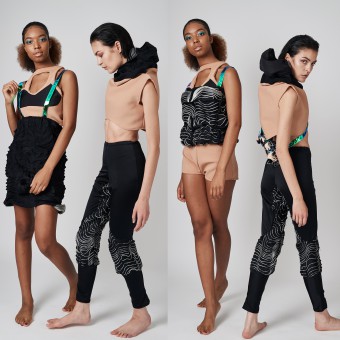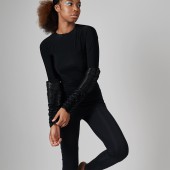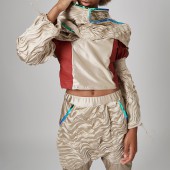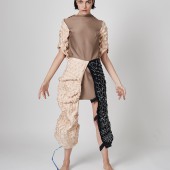Materializing the Digital Transformable Fabrics 3D Printed by Valentina Favaro |
Home > Winners > #92045 |
 |
|
||||
| DESIGN DETAILS | |||||
| DESIGN NAME: Materializing the Digital PRIMARY FUNCTION: Transformable Fabrics 3D Printed INSPIRATION: These designs investigate the possibility to create a new category of fabrics enabling movement and using it as source of inspiration for the creation of new shapes. The narration behind this is a reflection on the digital ages we are living in, where virtual is overwhelming the physical aspects of life. We are now digital people in digital environments. How can we save the material world? This is the story, or better say, the wardrobe, of a digital era, of the materialization of movement. UNIQUE PROPERTIES / PROJECT DESCRIPTION: These designs explore how movement can be embodied in our urban garments through the use of programmable materials in response to the digital era.Aiming to analyze the relation between body and movement, through the connection with materials, and their adaptation and reaction to this. Materialization means to assume material form: the emphasis is on reality and perception. To materialize the movement is a path which has not only a conceptual and social goal, but also a functional one. OPERATION / FLOW / INTERACTION: These clothes have been design studying a way to embrace the movement of our body and, at the same time, as a reflection on how this digital era is making everything more virtual, literally tracing the shape of movement on fabrics. So both, functional and conceptual. On the practical aspect this has been made choosing three activities that are riding our urban scenario (biking, skating and running), and which makes us needing adaptable clothing more and more everyday. People movements, making these activities, have been analysed through the use of motion capture. The movements has been traced through the use of Maya software, and after it studied and elaborated into skatches. In these phase the functional part has been interwoven with the conceptual one. Once decided the shapes and movements for every outfit, the fabrics has been stretched on a 3d printer and printed, so once released it could shrink into shapes. After this the design was sewn ( due to the little dimension of the 3d printer plate every part has been divided in more and sewn together) PROJECT DURATION AND LOCATION: The project started in Ravensbourne university in January 2019 and ended as my own dissertation in October 2019. |
PRODUCTION / REALIZATION TECHNOLOGY: This work focuses on the programmable fabrics: this means fabrics which are stretchable and can react, trough shrinking, to the contrast of the more solid matter 3d printed on them. In prestressed textiles, textiles with a high degree of elasticity, such as neoprene and jersey, can be used as the active material of the programmable composite. Less elastic material, such as plastic, can be used as the non-active material to structure the textile and constrain its stretched state. Moreover the research beginning the shapes study, and done on the movements of the body during different activities, has been done through the motion capture of people biking, running and skating. SPECIFICATIONS / TECHNICAL PROPERTIES: Transformable 3d printed fabrics are a research based on the development of programmable materials. Printing with a solid material ( in this case verbatim primalloy to assure the right solidity meanwhile being flexible on the body) on a stretched fabric, means when the fabric will be released it will take different shapes based on the texture which has been printed. Every piece of fabric has been done 40 for 40 cm when stretched ( the dimension of the available 3d printer I had) and less, depending on the texture, when realised. In these way fabrics become adaptive and reactive. Before it the use of motion capture has been really useful to understand body movements during the activities and to analyze and research to later design. TAGS: programmable fabrics, transformable fabrics, digital era, 3d printing, movement, adaptation, reaction, materialisation, changeability RESEARCH ABSTRACT: The aim of this research is to analyze and underline the relation between body and movement, through the connection with materials, and their adaptation and reaction to this. This research explores the possibility to create a new category of fabrics . The narration behind this is a reflection on the digital ages we are living in, where virtual is overwhelming the physical aspects of life. We are now the new tribe of digital natives. Digital people in digital environments. The research explores the question: how can movement be embodied in our urban garments through the use of programmable materials in response to the digital era? Moreover, in support to the conceptual world of materialization versus volatility, of tangible vs intangible, physical vs virtual, it follows an investigation on what is movement, how we can produce and trace it. The focus is on the challenge of materialize our movements, in order to bring awareness on our situation. What would be a world only virtual? How can we save the material world? We need to investigate the essence of our physical body, the movement. This is the story, or better say, the wardrobe, of our new digital era; of the materialization of movement. CHALLENGE: The hardest part has been facing the production possibilities, and still is open a question on how to produce the collection on a large scale. Besides also the design challenge of putting together a conceptual reflection on our time, and a functional study for our body. ADDED DATE: 2019-09-23 11:01:39 TEAM MEMBERS (1) : IMAGE CREDITS: Image #1: photographer Suthathip Saepung/ model Savannah Smith/ model Sara Dett /creator Valentina Favaro Image #2: photographer Suthathip Saepung/ model Savannah Smith/ model Sara Dett /creator Valentina Favaro Image #3: photographer Suthathip Saepung/ model Savannah Smith/ creator Valentina Favaro Image #4: photographer Suthathip Saepung/ model Savannah Smith/ creator Valentina Favaro Image #5: photographer Suthathip Saepung/ model Sara Dett /creator Valentina Favaro |
||||
| Visit the following page to learn more: https://www.instagram.com/valentina.fava |
|||||
| AWARD DETAILS | |
 |
Materializing The Digital Transformable Fabrics 3d Printed by Valentina Favaro is Winner in Textile, Fabric, Textures, Patterns and Cloth Design Category, 2019 - 2020.· Read the interview with designer Valentina Favaro for design Materializing the Digital here.· Press Members: Login or Register to request an exclusive interview with Valentina Favaro. · Click here to register inorder to view the profile and other works by Valentina Favaro. |
| SOCIAL |
| + Add to Likes / Favorites | Send to My Email | Comment | Testimonials | View Press-Release | Press Kit | Translations |
Did you like Valentina Favaro's Textile Design?
You will most likely enjoy other award winning textile design as well.
Click here to view more Award Winning Textile Design.








